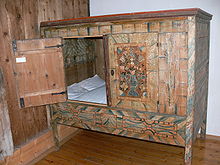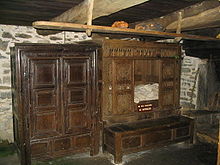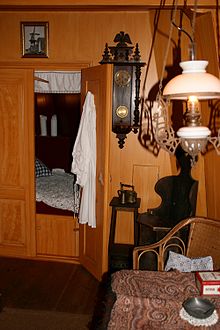- Box-bed
-
A box-bed (or closed bed, close bed, enclosed bed) is a bed enclosed in furniture that looks like a cupboard, half-opened or not.
The box-bed is closed on all sides by panels of wood. One enters it by removing curtains, opening a door hinge or sliding doors on one or two slides. The bed is placed on short legs to prevent moisture due to a dirt floor.
In front of the box-bed was often a large oaken chest, with the same length as the bed. This was always the 'seat of honour,' and served also as a step for climbing into the bed. It was also used to store clothing, underwear and bedding the rest of the time.[1]
Contents
The closed-bed in Britanny
In French Britanny, the closed-bed (French: lit-clos) is a traditional furnishing. In homes with usually only one room, the box-bed allowed some privacy and helped keep people warm during winter.
Some closed-beds were built one above the other in a double-decker, two-story arrangement. In this case, young people were sleeping upstairs.[2]
It was the main furniture of rural houses in Britanny until the 20th century. Often carved and decorated, it was the pride of its owners.
Closed-beds were 1.60 to 1.70 m length, long enough for people of that region who were rather small. And because they slept in almost a sitting position, they leaned on three or four pillows.[3] It was the tradition of the Middle Ages not to sleep lying down, because that is the position of the dead and of effigies.
Later out of fashion and expensive to make, box-beds were gradually abandoned in the 19th and 20th centuries. Fine pieces were put in museums (Lampaul-Guimiliau, Nantes, Quimper, Rennes, St-Brieuc), while most of them were converted into bookshelves, dressers or TV cabinets. In the 21st century, rental companies offer nights in authentic box-beds.
Box-beds were also used to protect people of the home from the animals (pigs, hens) also living in the house, [4] or even to protect them from wolves who might enter houses and snatch babies.
The closet-bed in the Netherlands
In the Netherlands the closet-bed, or bedstede, were common into the 19th century, especially in farmhouses in the countryside. Closet-beds were closed off with a door or a curtain.
One of the advantages of the closet-bed was that it could be built into the living room and closed off during the day, making a separate bedroom unnecessary. The other main advantage was that, during the winter, the small area of the closet-bed would be warmed by body heat. As a result, the stove did not need to be stoked overnight. The door would not be shut completely, but left open a crack.
During the 16th and 17th century, closet-beds were much smaller. Lying down was associated with death, and therefore sleeping was done in a half-upright position. These closet-beds slept two people, and beneath them were often doors for children.
In literature
Box-beds are mentioned in Georges Simenon's detective novel The Patience of Maigret (originally, Le chien jaune, 1936), republished as Maigret and the Yellow Dog. In a house with pretentious furnishings, the detective notices "Breton closet-beds [sic] transformed into vitrines".[5] A box bed is also mentioned in Tim Powers' Declare.
References
- ^ http://www.oldandinteresting.com/breton-box-beds.aspx
- ^ Thomas and Frances Trollope, A Summer in Brittany, 1840.
- ^ (French) Ils sont fous ces Bretons#Coop Breizh|Erwan Vallerie, p. 104
- ^ http://www.wagner-juergen.de/franz/litclos.htm
- ^ Maigret and the Yellow Dog, Harcourt Brace Jovanovich, 1987, p. 23.
Bedding Bed types Bassinet · Box-bed · Bunk bed · Cage bed · Camp bed · Canopy bed · Couch · Couch bed · Four poster bed · Futon · Hammock · Hospital bed · Infant bed · Lit a la turque · Manjaa · Murphy bed · Petate · Platform bed · Sleigh bed · Sofa bed · Toddler bed · Trundle bed · Waterbed · DaybedBed components Air mattress · Bed base · Bed frame · Bed skirt · Bed warmer · Box-spring · Bunkie board · Cot side · Featherbed · Headboard · Mattress · Mattress pad · Mattress protector · Memory foam · Nightstand · Orthopedic mattress · SheetBlankets Afghan · Button blanket · Comforter · Duvet · Electric blanket · Fire blanket · Hudson's Bay point blanket · Patchwork quilt · Photo blanket · Pierzyna · Quilt · Security blanket · Silk comforterPillows Acupressure pillow · Bamboo wife · Bolster · Contour leg pillow · Cushion · Dakimakura · Eye pillow · Love pillow · Orthopedic pillow · Phonetic pillow · Sex pillow · Speaker pillow · Throw pillow

This article about furniture or furnishing is a stub. You can help Wikipedia by expanding it.



